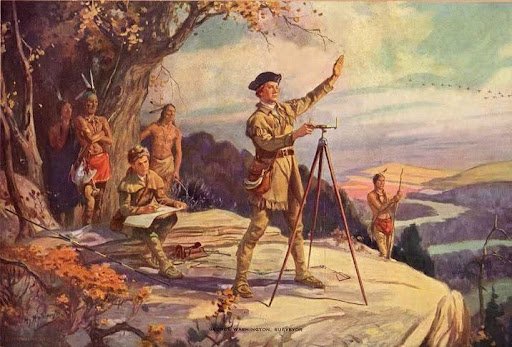When we think of George Washington, the grand speeches and solemnity of his presidency come to mind.
However, we often forget a part of George Washington’s legacy—his role in developing canals, roads, or land surveys. When we dive into George’s life, we find a lot. His charisma and Western ambitions reveal a man equally driven by the untamed frontier as by the ideals of a nascent republic.
Washington the Surveyor: Seeds of an Explorer
A teenage Washington roamed the unfamiliar lands of Virginia’s Northern Neck years before the Revolutionary War. As a surveyor, he not only mapped out vast swathes of wilderness but developed an appreciation for the potential of the western territories.
For Washington, this was more than a profession; it was a vision. He saw the Potomac River as the door that would connect the East and West, bridging the coastal states to the Ohio Valley.
Land Speculator and Visionary
Washington’s land acquisitions were not merely speculative—they were strategic. By his death, the president owned over 65,000 acres across Ohio, Pennsylvania, and Virginia. When analyzing Washington’s belief in the West as the economic and geopolitical future of the United States, one cannot overlook these investments.
For Washington, the frontier region embodied opportunity, freedom, and the American spirit.
Bridging the East and West
Washington’s presidency often overshadowed his engineering pursuits, but his contributions to infrastructure are nothing short of visionary. He played an instrumental role in developing early routes westward:
The Patowmack Canal Project
As president of the Patowmack Canal Company, Washington aimed to make the Potomac accessible. He envisioned a future that would open new doors of connectivity and economic ties between the eastern and western states. The project came with its fair share of complexities, but its legacy laid the groundwork for future endeavors like the Erie Canal.
The National Road
Washington’s advocacy for an overland route across the Appalachians eventually led to the construction of the Cumberland Road. His military campaigns and knowledge of trails like Nemacolin’s Path influenced the route’s planning.
The Frontier Spirit
Washington’s fascination with the West wasn’t confined to his youth. Even as the first president, he championed Western development, which was essential for national unity. He famously remarked, “Such a canal [on the Potomac] would bind settlers to us by a chain which never can be broken.”
More Than Just a President
Washington’s ambitions show us a side of him that isn’t often talked about. It’s important to remember that besides his mavericks as a statesman and a soldier, he was a man with a modern approach. His vision anticipated the 19th-century ethos of Manifest Destiny and laid the foundation for the nation’s transcontinental ambitions.
The story of George Washington is a story of a proud man with eyes that could see the future. His ambitions laid the foundation of America’s greatness. Over two centuries after his death, his Western dreams remain an integral, albeit lesser-known, chapter of his immortal legacy.
Norman Tyler’s Crossing the Continent: The Stories of Transportation Trailblazers is a book that every true American must read. It is a homage to George Washington’s heroics and takes the readers back into the nation’s history and America’s ambitions for a fully functional transportation system.



